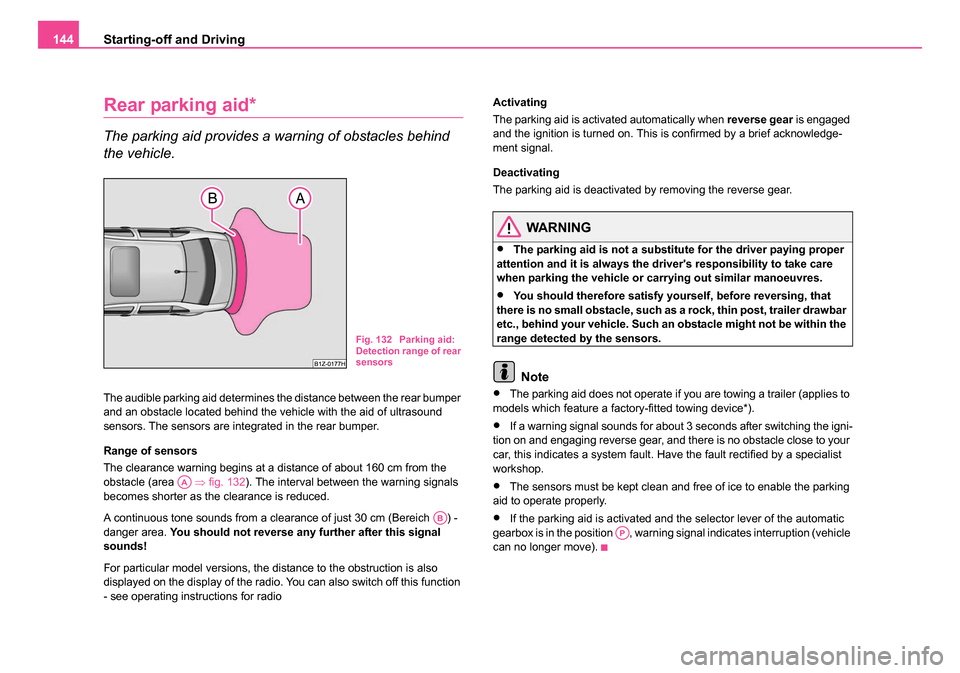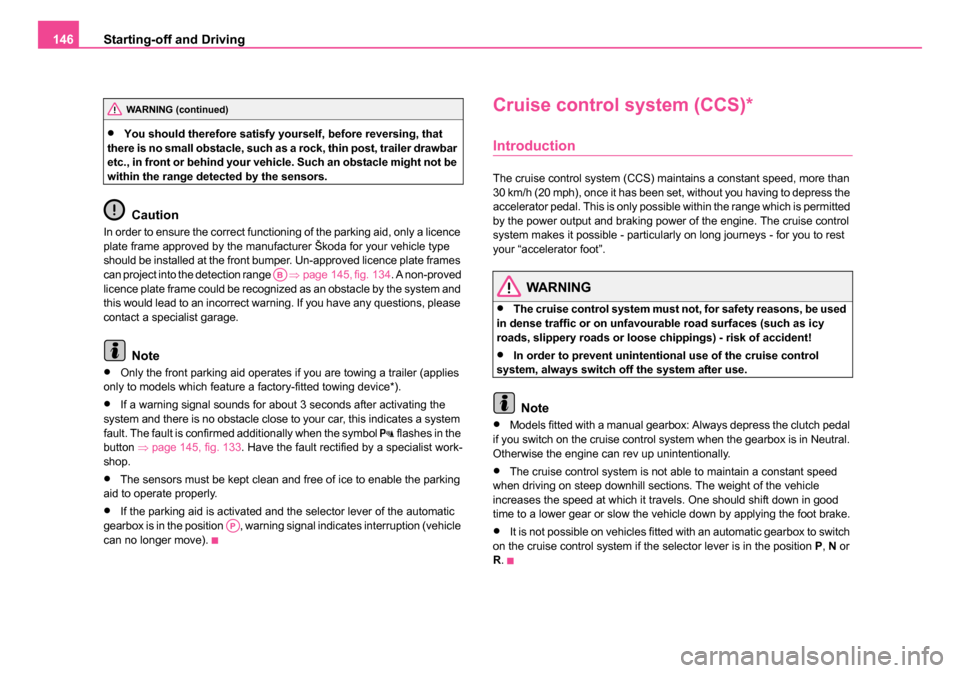parking sensors SKODA OCTAVIA 2005 1.G / (1U) Owner's Manual
[x] Cancel search | Manufacturer: SKODA, Model Year: 2005, Model line: OCTAVIA, Model: SKODA OCTAVIA 2005 1.G / (1U)Pages: 315, PDF Size: 11.8 MB
Page 145 of 315

Starting-off and Driving
144
Rear parking aid*
The parking aid provides a warning of obstacles behind
the vehicle.
The audible parking aid determines the distance between the rear bumper
and an obstacle located behind the vehicle with the aid of ultrasound
sensors. The sensors are integrated in the rear bumper.
Range of sensors
The clearance warning begins at a distance of about 160 cm from the
obstacle (area ⇒ fig. 132). The interval between the warning signals
becomes shorter as the clearance is reduced.
A continuous tone sounds from a clearance of just 30 cm (Bereich ) -
danger area. You should not reverse any further after this signal
sounds!
For particular model versions, the distance to the obstruction is also
displayed on the display of the radio. You can also switch off this function
- see operating instructions for radio Activating
The parking aid is activated automatically when
reverse gear is engaged
and the ignition is turned on. This is confirmed by a brief acknowledge-
ment signal.
Deactivating
The parking aid is deactivated by removing the reverse gear.
WARNING
•The parking aid is not a substitute for the driver paying proper
attention and it is always the driver's responsibility to take care
when parking the vehicle or carrying out similar manoeuvres.
•You should therefore satisfy yourself, before reversing, that
there is no small obstacle, such as a rock, thin post, trailer drawbar
etc., behind your vehicle. Such an obstacle might not be within the
range detected by the sensors.
Note
•The parking aid does not operate if you are towing a trailer (applies to
models which feature a factory-fitted towing device*).
•If a warning signal sounds for about 3 seconds after switching the igni-
tion on and engaging reverse gear, and there is no obstacle close to your
car, this indicates a system fault. Have the fault rectified by a specialist
workshop.
•The sensors must be kept clean and free of ice to enable the parking
aid to operate properly.
•If the parking aid is activated and the selector lever of the automatic
gearbox is in the position , warning signal indicates interruption (vehicle
can no longer move).
Fig. 132 Parking aid:
Detection range of rear
sensors
AA
AB
AP
s24s.book Page 144 Thursday, November 24, 2005 12:27 PM
Page 146 of 315

Starting-off and Driving145
Using the systemSafetyDriving TipsGeneral MaintenanceBreakdown assistanceTechnical Data
Front and rear parking aid*
The parking aid provides a warning of obstacles in front
and behind the vehicle.
The audible parking aid determines the distance between the front or rear
bumper and an obstacle with the aid of ultrasound sensors. The sensors
are integrated in the front and rear bumper. The signal tones for the front
parking aid sound higher than for the rear parking aid.
Range of sensors
The distance warning begins at a distance of about 120 cm from the
obstacle in front of the vehicle (area ⇒fig. 134 ) and about 160 cm from
the obstacle behind the vehicle (area ⇒page 144, fig. 132 ). The
interval between the warning signals becomes shorter as the clearance is
reduced.
A continuous tone sounds from a clearance of just 30 cm (Bereich ) -
danger area. You should not reverse any further after this signal
sounds!
Your vehicle can be equipped with a radio which shows on its display the
distance of the vehicle to the obstacle. You can also switch off this func-
tion - see operating instructions for radio
Activating
The parking aid is activated when the reverse gear is engaged and the
ignition is turned on or by pressing the button ⇒fig. 133 - the symbol
lights up in the button. The activation is confirmed by a brief acknowledge-
ment signal.
Deactivating
The parking aid is deactivated after pressing the button
⇒ fig. 133 or at
a speed of more than 15 km/h - the symbol in the button is no longer
illuminated.
WARNING
•The parking aid is not a substitute for the driver paying proper
attention and it is always the driver's responsibility to take care
when reversing the vehicle or carrying out similar manoeuvres.
Fig. 133 Activating the
parking aid
Fig. 134 Parking aid:
Detection range of the
front sensors
AAAA
AB
s24s.book Page 145 Thursday, November 24, 2005 12:27 PM
Page 147 of 315

Starting-off and Driving
146
•You should therefore satisfy yourself, before reversing, that
there is no small obstacle, such as a rock, thin post, trailer drawbar
etc., in front or behind your vehicle. Such an obstacle might not be
within the range detected by the sensors.
Caution
In order to ensure the correct functioning of the parking aid, only a licence
plate frame approved by the manufacturer Škoda for your vehicle type
should be installed at the front bumper. Un-approved licence plate frames
can project into the detection range ⇒page 145, fig. 134 . A non-proved
licence plate frame could be recognized as an obstacle by the system and
this would lead to an incorrect warning. If you have any questions, please
contact a specialist garage.
Note
•Only the front parking aid operates if you are towing a trailer (applies
only to models which feature a factory-fitted towing device*).
•If a warning signal sounds for about 3 seconds after activating the
system and there is no obstacle close to your car, this indicates a system
fault. The fault is confirmed additionally when the symbol
flashes in the
button ⇒page 145, fig. 133 . Have the fault rectified by a specialist work-
shop.
•The sensors must be kept clean and free of ice to enable the parking
aid to operate properly.
•If the parking aid is activated and the selector lever of the automatic
gearbox is in the position , warning signal indicates interruption (vehicle
can no longer move).
Cruise control system (CCS)*
Introduction
The cruise control system (CCS) maintains a constant speed, more than
30 km/h (20 mph), once it has been set, without you having to depress the
accelerator pedal. This is only possible within the range which is permitted
by the power output and braking power of the engine. The cruise control
system makes it possible - particularly on long journeys - for you to rest
your “accelerator foot”.
WARNING
•The cruise control system must not, for safety reasons, be used
in dense traffic or on unfavourable road surfaces (such as icy
roads, slippery roads or loose chippings) - risk of accident!
•In order to prevent unintentional use of the cruise control
system, always switch off the system after use.
Note
•Models fitted with a manual gearbox: Always depress the clutch pedal
if you switch on the cruise control system when the gearbox is in Neutral.
Otherwise the engine can rev up unintentionally.
•The cruise control system is not able to maintain a constant speed
when driving on steep downhill sections. The weight of the vehicle
increases the speed at which it travels. One should shift down in good
time to a lower gear or slow the vehicle down by applying the foot brake.
•It is not possible on vehicles fitted with an automatic gearbox to switch
on the cruise control system if the selector lever is in the position P, N or
R .
WARNING (continued)
AB
AP
s24s.book Page 146 Thursday, November 24, 2005 12:27 PM